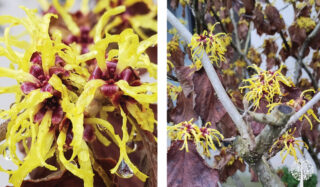Plant Of The Month: Witch Hazel Is A Perfect Addition To Biodiverse Gardens
I adore witch hazel and its whimsical blossoms! In my climate, the lemon-yellow ribboned flowers pop open in early February and bloom into March. Some people grow this plant for its medicinal qualities; others grow it simply because it adds beauty to the garden.
Witch hazel is a member of the Hamanelidacease family and needs space. It can reach 9 meters tall and 4.5 meters wide at full maturity! I’m okay with that because the bigger it grows, the more intriguing blooms it produces.
Light, Soil, and Hardiness
Caring for witch hazel requires minimal effort; it likes moist soil and thrives in part shade to full sun. The home gardener must water regularly and prune after it blooms to promote next year’s buds.
The more endearing thing about witch hazel is its love of the cold. It is hardy to climate zone 3 (-40°C). Most varieties of witch hazel demand a chill period of at least 7°C to bloom.
Propagation and Transplanting
Witch hazel can be grown in a pot, perfect for smaller garden spaces. But the tree propagates through the spreading of underground suckers, so it can eventually feel confined if kept in a container. Cutting off the suckers as they emerge from the ground will help contain the spread. It’s also a great way to propagate a new tree! Dig up the suckers with as much of the root as possible and transplant them into a new container or in the ground.
Transplanting an entire plant is possible, but despite its hardy deposition, witch hazel is a homebody. It doesn’t like change and can go into shock. This may mean dropping leaves and no blooms for a season or two.


Pests and Diseases
The usual suspects are the most common annoyances for witch hazel: deer, aphids, leaf spot, or powdery mildew may attack the plant. A good hosing of water should do the trick in removing aphids. Add a deer barrier around the tree trunk to keep bigger pests at bay.
Common Varieties
In addition to American witch hazel, these varieties are the most popular for the home garden, all producing the quintessential yellow blossom with a plum center.
Chinese witch hazel (Hamamelis mollis) grows up to 26 feet tall and is hardy to climate zones 5-8.
Japanese witch hazel (Hamamelis japonica) grows 10 to 15 feet tall; it blooms from January to March.
Ozark witch hazel (Hamamelis vernalis): Native to the Ozark Mountains in Arkansas and Missouri, this species blooms in February.
Fun Facts
Witch hazel is the only blossoming tree in North America with flowers, ripe fruit, and next year’s buds on its branches simultaneously!
Witch hazel adds to the garden’s biodiversity by providing food for pollinators and homes for nesting birds. This plant is a great conversational centerpiece, especially for history buffs. First Nations and early settlers used witch hazel to find underground water sources, wells, and aquifers. A forked or bent witch hazel branch was used as a divining rod. If the branch twisted or dipped, this indicated the presence of underground water. The practice was called “water-witching” and led to the plant’s common name, witch hazel.
Join me next month as we garden and grow together!




